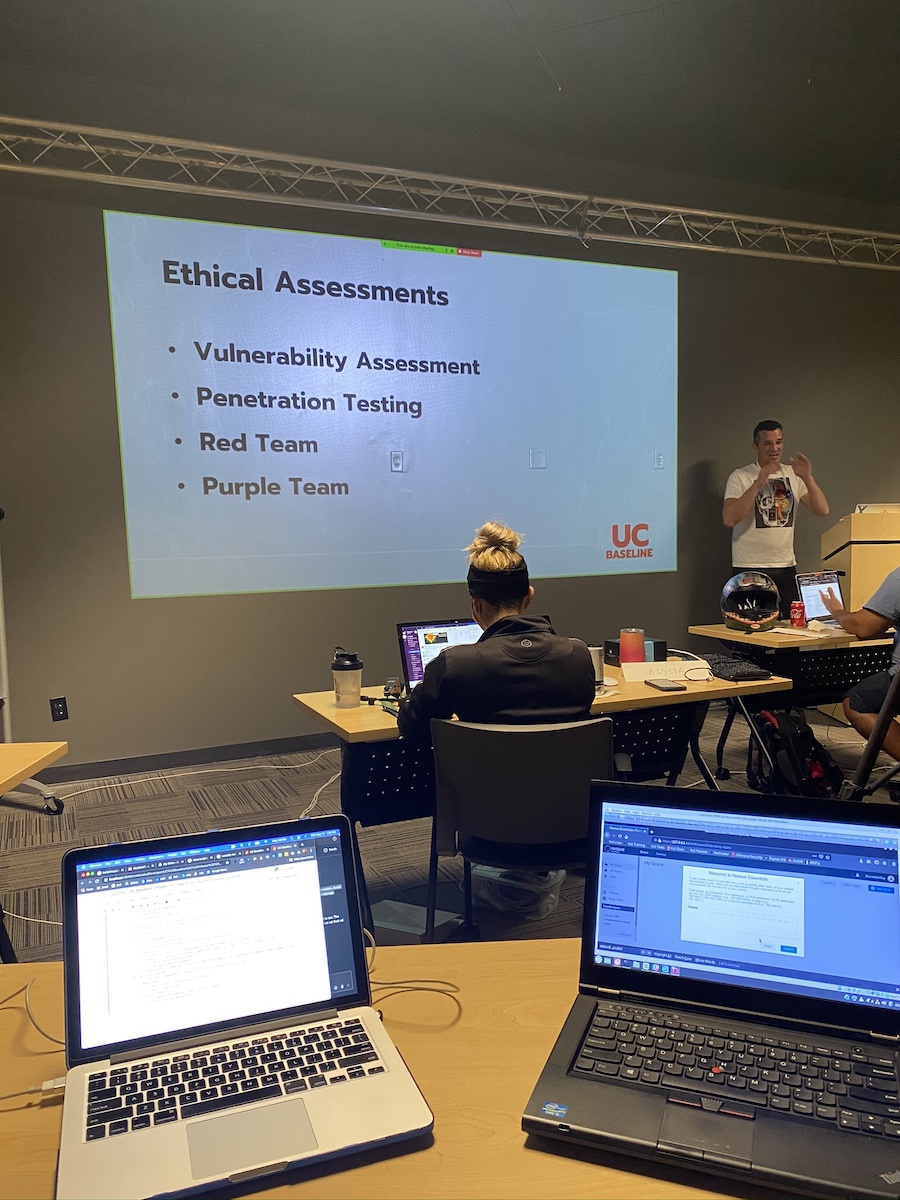
All dressed up for a 📱 PHONE ☎️ interview. Sure, they won’t know I’m dressed up, but I’LL KNOW.
 The class portion of UC Baseline — the cybersecurity training program offered by The Undercroft, Tampa Bay’s security guild — ended yesterday with the final day of Python 101, which marks the end of classes. Every weekday for the past five weeks, 8:00 a.m. to 4:00 p.m., I’ve been in a classroom (masked and socially distanced, of course), studying and furiously taking notes in the following classes:
The class portion of UC Baseline — the cybersecurity training program offered by The Undercroft, Tampa Bay’s security guild — ended yesterday with the final day of Python 101, which marks the end of classes. Every weekday for the past five weeks, 8:00 a.m. to 4:00 p.m., I’ve been in a classroom (masked and socially distanced, of course), studying and furiously taking notes in the following classes:
| Course | Instructor |
|---|---|
| Hardware 101 (5 days) |
Tremere |
| Networking 101 (5 days) |
TreyCraf7 |
| Linux 101 (3 days) |
Cochise |
| Windows 101 (2 days) |
Turtle |
| Infosec 101 (5 days) |
KobyBeefcake TheCleverShark |
| Python 101 (3 days) |
KobyBeefcake |
There are still two more days in the program. Today is the “Get a Job” career fair. The Undercroft have gathered a series of recruiters, security companies, and agencies to talk to us, including:
The presentations are quite good — I’m pretty impressed by the representatives I’ve seen so far.
I’m also dressed and masked for the occasion:

For the past four weeks, I’ve been spending over eight hours a day in a classroom in Ybor City, as a student in the inaugural cohort of UC Baseline, the cybersecurity training program offered by Tampa Bay’s security guild, The Undercroft.
We’ve taken the following courses under the tutelage of these instructors:
| Course | Instructor |
|---|---|
| Hardware 101 (5 days) |
Tremere |
| Networking 101 (5 days) |
TreyCraf7 |
| Linux 101 (3 days) |
Cochise |
| Windows 101 (2 days) |
Turtle |
| Infosec 101 (5 days) |
KobyBeefcake TheCleverShark |
There’s just one course left in the program: Python 101, which starts today! Considering that I’ve just come from teaching a Python course to beginners, I suspect that the instructors will have me:
The Python 101 course will run from Monday to Wednesday. After that comes…
…the virtual job fair. The Undercroft will set up online interviews between UC Baseline students/Undercroft guild members and representatives from Tampa Bay security and security-adjacent companies looking to hire. I see some resume editing and LinkedIn profile polishing in my near future.
Friday will be devoted to graduation rituals, which include a solo Capture the Flag competition and a grad barbecue (socially distanced, of course — they’ve got a nice courtyard).
I’m looking forward to the week!
If you take The Undercroft’s five-week cybersecurity course, UC Baseline, you will have to absorb a lot of material. Right now, I feel like the cat in the video above.

 Last night was the final night of the Intro to Python Coding course that I’ve been teaching on behalf of Computer Coach for the past five weeks — Mondays and Wednesdays, 6:00 p.m. to 10:00 p.m..
Last night was the final night of the Intro to Python Coding course that I’ve been teaching on behalf of Computer Coach for the past five weeks — Mondays and Wednesdays, 6:00 p.m. to 10:00 p.m..
I’d like to congratulate the students! It’s not easy to spend four hours an evening twice a week learning something completely new and unknown to you, but the students did just that. If you’ve ever been in any of my Tampa iOS Meetup sessions, you’ve seen my teaching technique — you’re not passively watching slides, but coding along with me, and even experimenting, just to see what happens. That’s I what I did with the Python class — we entered code and saw what happened, hopefully learning along the way.
As a farewell present to the students, I sent them a copy of So You Want to be a Wizard, a little “zine” written by Julia “b0rk” Evans for programmers who are starting out that’s full of good advice. I hope it helps them through those moments that every programmer has, when nothing seems to work and all you want to do is throw your computer out the window. I’ve posted it here as well, partly because it’s full of good advice that even experts need to remember, and partly because I want to make sure that everyone knows about Julia’s works.
Even the table of contents lets you that that you’re in for a fun read:
 Julia has a whole set of zines, some of which are free…
Julia has a whole set of zines, some of which are free…
 …and some fancier ones, which come at a reasonable price, even for groups:
…and some fancier ones, which come at a reasonable price, even for groups:
Once again, congratulations to the Intro to Python Coding students!
 It’s “Case the Joint Day” at UC Baseline, the cybersecurity training program offered by Tampa Bay’s security guild, The Undercroft. We’ve been provided with two target computers — one on the local network set up in the classroom, and one virtual machine set up remotely in the cloud — to examine via all manner of network analysis programs for weak spots.
It’s “Case the Joint Day” at UC Baseline, the cybersecurity training program offered by Tampa Bay’s security guild, The Undercroft. We’ve been provided with two target computers — one on the local network set up in the classroom, and one virtual machine set up remotely in the cloud — to examine via all manner of network analysis programs for weak spots.
Now the fun really begins! I’ll keep you posted, and write a more detailed article later. In the meantime, there’s mischief I have to get to.

It’s Day 2 of InfoSec Week at UC Baseline, the cybersecurity training program offered by Tampa Bay’s security guild, The Undercroft. I’ve fired up Kali — a distribution of Linux made for cybersecurity types and other troublemakers — and am marveling at the hacking goodies contained within.

 I’ll write more as we go through the exercises, which includes fun activities including:
I’ll write more as we go through the exercises, which includes fun activities including:
Watch this space!